#herpetofauna
Explore tagged Tumblr posts
Text
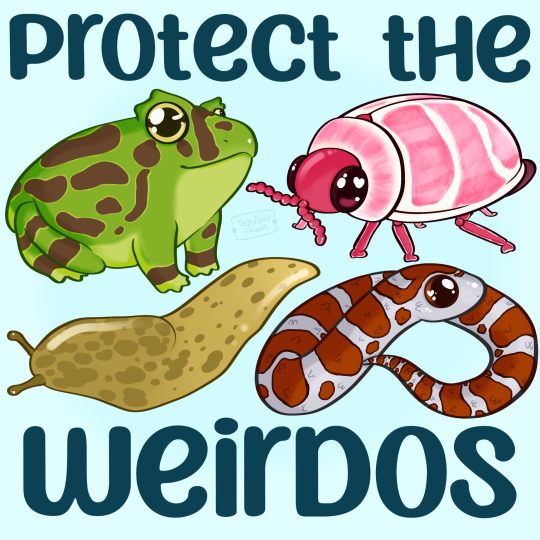
Protect them ✨🪲🐍🐸🪱🐝🐛🦋🐌🐞🐜🐢🕷️🪰🪳🦟🦗🦎✨
Patreon | Etsy
@onenicebugperday
#herpetology#herpetofauna#entomology#bugs#insects#snakes#frogs#artists on tumblr#digital art#squishyfauna#etsy#patreon
7K notes
·
View notes
Text

Spiny softshell turtles (Apalone spinifera) along the river 5/22/24
#turtles#turtle#mine#reptile#reptiles#herpetology#herpetofauna#nature#wildlife#naturalist#nature photography#photography#ecology#north america#animals#ecologist#wildlife biology#wildlife biologist#wildlife photography#original photography#original photographers#herps
764 notes
·
View notes
Text
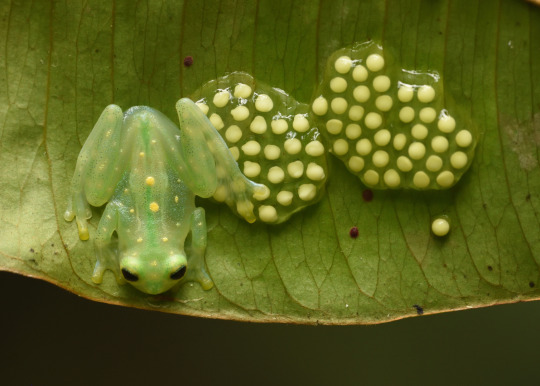
Hyalinobatrachium aureoguttatum
#atrato glass frog#sun glass frog#Hyalinobatrachium aureoguttatum#wikipedia#wikipedia pictures#nature#animals#frogs#froggy#herpetology#herpblr#frogblr#frog#frogcore#frog eggs#herpetofauna#wikimedia commons#amphibia#amphibians#anura#centrolenidae#glass frog#glass frogs
349 notes
·
View notes
Text
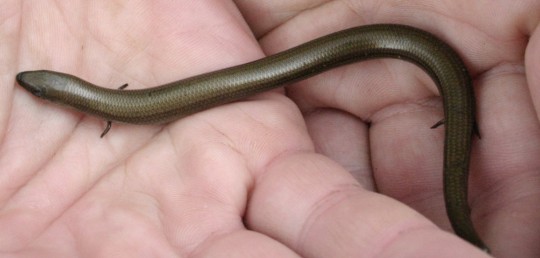
Italian Three-Toed Skink (Chalcides chalcides)
Family: Skink Family (Scincidae)
IUCN Conservation Status: Least Concern
Like several other species of lizard, the Italian Three-Toed Skink has adapted to move through areas covered with dense vegetation by developing an elongated, flexible, snake-like body with highly regressed limbs, although unlike many other "snake-like lizards" members of this species still possess four tiny limbs, each ending in a stumpy three-toed foot. Said limbs are far too small to support the skink's weight and serve no role in movement (which is achieved through an elegant snake-like slithering motion,) which has led many to question what purpose, if any, they serve; it is generally assumed that the limbs are vestigial and that, given sufficient time, the descendants of modern Italian Three-Toed Skinks will lose them entirely, although some herpetologists and evolutionary biologists have suggested that the continued existence of this species' limbs suggests that they must serve some function, such as being moved as part of a courtship display or allowing mating individuals to hold onto one another (although as these behaviours have never been observed these suggestions are entirely speculative.) Found in damp, well-vegetated areas across most of mainland Italy as well as Tunisia, Algeria, Libya and the nearby island of Sardinia, members of this species are diurnal, feed mainly on insects and breed during the spring; like most skinks, females of this species give birth to live young, with newborns, which resemble miniature adults, being independent immediately after birth.
--------------------------------------------------------------------------
Image Source: https://www.inaturalist.org/taxa/53646-Chalcides-chalcides
#Italian Three-Toed Skink#skink#skinks#animal#animals#zoology#biology#herpetology#herpetofauna#wildlife#european wildlife#african wildlife#reptile#reptiles#lizard#lizards#squamata#squamates
898 notes
·
View notes
Text
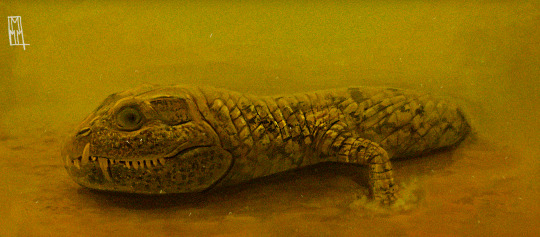
Vancleavea campi at the bottom of a river.
An extrange semi-aquatic non-archosaurian archosauriform from the Late Triassic of North America.
#zoology#animals#reptiles#paleoart#nature#art#wildlife#triassic#herpetofauna#fauna#animalia#paleontology
484 notes
·
View notes
Text
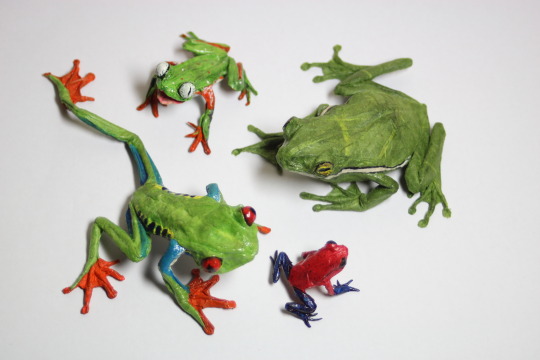
Old photo of my origami frogs.
#origami#paper folding#art#artists on tumblr#origamiart#papercraft#animal#herpetofauna#herpetology#i love frogs#poisonous frog#tree frog#frogs#frog#frog art#paper sculpture#paper art#paper#texture#color#colorful#shapes
88 notes
·
View notes
Text
Day 113: Newts and Co. Notice the olm (here called proteus) at the top

link
–This image is part of the public domain, meaning you can do anything you want with it ! (you could even sell it as a shirt, poster or whatever)–
#art#copyright#free art#open source#public domain#flickblr#flickr#nature#biology#amphibian#salamander#newt scamander#herps#herpetology#herpetofauna#olm#pictorial works#siren#spotted salamander#great water newt#proteus
56 notes
·
View notes
Text

#ballpoint doodle#ballpoint pen#ball point drawing#ball point pen#ball point art#ink#ink drawing#sketch#doodle#sketches#my art#sketch page#hatching#cross hatching#apple snail#pond snail#ball python#alligator#american alligator#crested gecko#herps#herpetology#herpetofauna
56 notes
·
View notes
Text






Literally cried over the first critter
#nature#gfdelmar og#herpetofauna#herpetology#amphiba#amphibian#amphibians#salamander#salamanders#frog#gray tree frog#red spotted newt#spotted salamander#ambystoma#spring salamander#black widow#spider#lichen
33 notes
·
View notes
Text
listen im NOT saying that when making venomous snake restriction laws we should NEVER consult hot keepers, but i AM saying that the word of veterinarians and zookeepers should be held to a higher regard than the word of Hotkeeper McFreehandlerson who has 45 inland taipans in tupperware containers
#shitpost#shitposting#sillyposting#herpetology#herpblr#snake#snakes#herpetoculture#herpetofauna#inland taipan#hot keepers#hot snakes#venomous snakes#venomous snake#snake rack#snake racks#taipan#snake keeping#reptile lover#reptile owner#reptile#reptiles
29 notes
·
View notes
Text
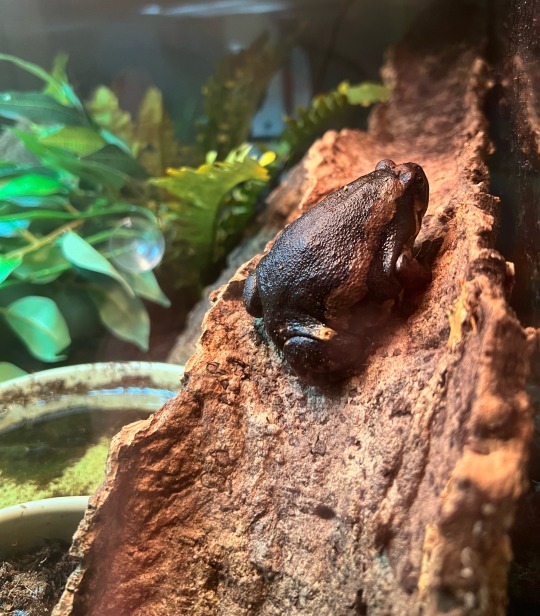
Who said potatoes can’t climb
37 notes
·
View notes
Text

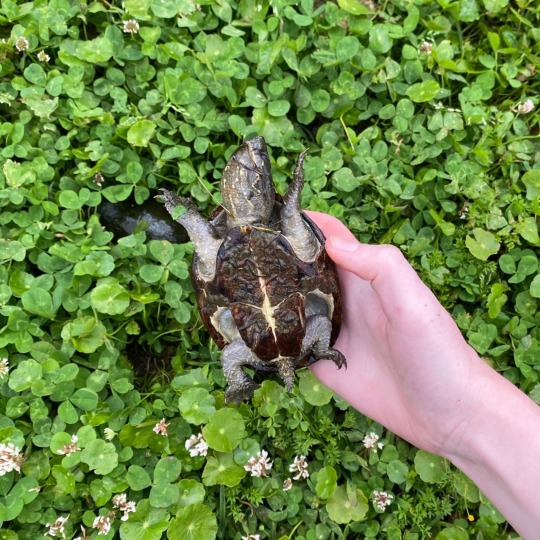
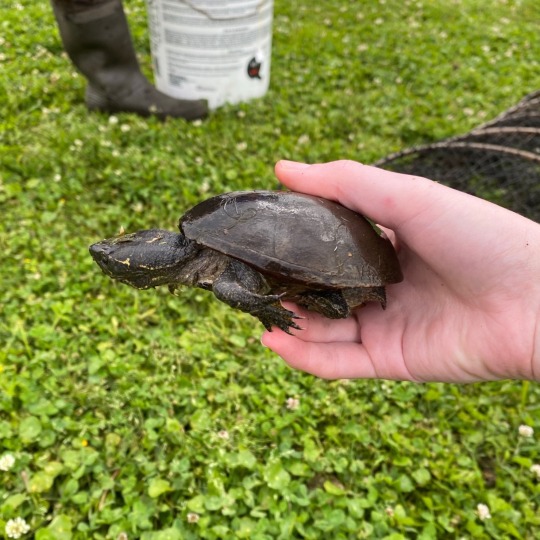

Stinkpot Turtle (Sternotherus odoratus) caught and released for a turtle study in a local bayou
Edit: For those curious, this species does have a unique smell. I wouldn’t say it’s awful, but it is strong. In my opinion, it smells like the overpriced soap you can find in any Earthbound Trading Co. It’s a musky/earthy smell.
Another notable thing about this species is its attitude. Stinkpots are very feisty when handled. Most turtles fight being handled, but Stinkpots are known for putting up an unexpectedly big fight for such teeny turtles. This attitude is one of my favorite things about them.
#goblincore#zoology academia#turtle#turtles#reptiles#herpetofauna#herpetology#herpblr#green academia#cozycore#warmcore#baby#goblin#animals#Wildlife#biology#biology academia#stem academia#science academia#green aesthetic#greencore
169 notes
·
View notes
Text

The Indian purple frog (Nasikabatrachus sahyadrensis), also known as the purple frog or the pig nose frog, is an endangered frog endemic to the Western Ghats of India.
Formally recognized in 2003, their only known relatives are the Seychelles Island Frogs.
Each specimen is around 1–3 in./6-9cm from snout to rear; males being a third of the size of the females. While its flattened body shape and squat limbs look unusual, it helps the frog stick to rocks and hold on through the strong currents of its native streams and rivers; the wedge-like head assists in burrowing.
Unlike most subterranean frogs, the Indian purple frog spends nearly all its time underground, which includes feeding. Their main food source is termites.
They only emerge during two weeks of monsoon season for breeding. Males emerge and call on the banks— the sound reminiscent of a chicken clucking. Males mount the females, who carry them to the rocky crevices where they lay their eggs. Over 3000 eggs are laid at the same time, and the tadpoles grow over 100 days.
Their main threats are the pet trade, consumption by locals (as they are believed to help with numerous lung ailments), and habitat loss.
#frogs#frog#biology#herpetology#zoology#Indian purple frog#Indian animals#wildlife#sciblr#bioblr#herpetofauna#amphibians#amphibia#frogblr
8 notes
·
View notes
Text

Cochranella mache
“Cochranella mache. Amplectant pair captured on the April 22, 2009 Rompe-frente rivulet (A) and a calling male (SVL = 26.4 mm, not collected) showing its profile and ventral views, photographed on the April 20, 2009 Rompe-frente rivulet, Bilsa Biological Station, northwestern Ecuador (B, C).” - via Wikimedia Commons
#cochranella mache#cochranella#wikipedia#wikipedia pictures#wikimedia commons#nature#animals#amphibia#amphiblr#amphibians#frogs#mache glassfrog#glass frog#mache cochran frog#animalia#chordata#chordates#anura#centrolenidae#zoology#herpetology#herpetofauna#herpblr#frogblr#froggy#glassfrog#bilsa biological station#ecuador#south america
39 notes
·
View notes
Text
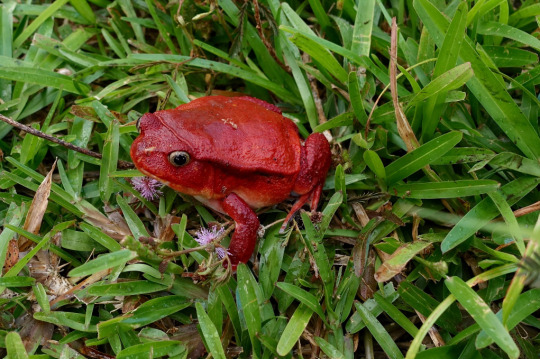
Tomato Frog (Dyscophus antongilii)
Family: Narrowmouth Frog Family (Microhylidae)
IUCN Conservation Status: Least Concern
Named for their rotund red bodies, Tomato Frogs are endemic to Madagascar where they are mostly found in wet, well-vegetated environments in the northeast. Spending the day buried beneath damp soil or leaf litter to avoid predation and dehydration, members of this species emerge at night to hunt for beetles, flies and other terrestrial arthropods, and respond to threats from nocturnal predators by inflating their bodies to appear larger and secreting a thick, sticky and mildly irritative substance from their skin, making them difficult for predators to bite or grab. Tomato Frogs breed following periods of heavy rainfall, and like almost all frogs they lay their eggs in water; males, which are smaller and paler than females, gather around suitable ponds or slow-moving rivers and streams during the night and produce low, quiet, grumbling calls, competing for the attention of females. If a female selects a male she will allow him to cling to her back and will carry him around for an extended period as she lays over 1,000 soft, transparent eggs which he fertilizes externally. Shortly after fertilization the eggs hatch into tiny, limbless, fully aquatic tadpoles that gradually develop limbs and lungs over the course of several months - after transitioning to life on land young Tomato Frogs are initially dull brown or pale yellow, gradually developing a redder colouration until they reach full maturity at 2-3 years of age.
------------------------------------------------
Image Source: Here
#tomato frog#Tomato Frog#frog#frogs#amphibian#amphibians#zoology#biology#herpetology#wildlife#African wildlife#herpetofauna
194 notes
·
View notes
Text

Happy flat fuck Friday to the Hellbender salamander (Cryptobranchus alleganiensis)
the Americas only giant salamander species! The little guy above is the eastern subspecies and the most common to find. Though they are elusive and declining in numbers because of sediment pollution and habitat fragmentation
Photo source:
10 notes
·
View notes